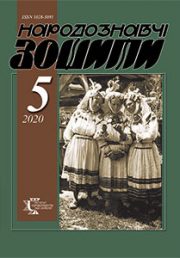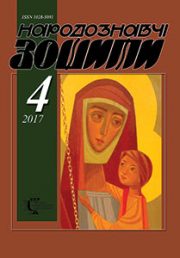The Ethnology Notebooks. 2020. № 2 (152), 276—292
UDK 94:[398.341:643.01](477.85)”18/19″
DOI https://doi.org/10.15407/nz2020.02.276
RADOVYCH Roman
ORCID ID: http://orcid.org/0000-0002-1900-8948
Doctor of Sciences in History,Senior Researcher
of the Institute of Ethnology
of the National Academy of Sciences of Ukraine,
in the Department of Historical Ethnology,
Svobody Avenue 15, 79000,
Lviv, Ukraine
Contacts: e-mail: radovychroman@gmail.com
Abstract. The author aims to find out, on the basis of materials from the Khotyn district, features of traditional housing construction of the second half of the 19th — beginning of the 20th centuries of Bukovyna Podillya, to reveal its local specifics and common features with the dwelling of Podillya and Transnistrian Pokuttya in the proposed exploration. The object of the study is the traditional construction of the Bukovina, and the subject is dwelling (planning, engineering and technology of construction of walls, ceilings, roofs, heating systems, etc.). The methodological basis of the study is the principle of historicism in combination with the elements of structural and functional analysis and the use of basic methods of ethnological science: typological, complex and retrospective analysis, historical reconstruction, etc. The territory of the study covers Khotyn district, Chernivtsi region. The basis of the work is the materials of the author, collected in the Khotyn district during 1987—2017, as well as archival materials of the Lviv Museum of Folk Architecture named after Klimenty Sheptytsky.
The most common were building of three-sections in two variants: «hata» + «horomy» + «komora» and «hata» + «komora» + «hata» («hatynchyna») in the second half of the 19th and early 20th centuries in Khotyn region.Dwelling of a frame structure with three basic constructive variants with filling walls by types: «killovani», «horodzheni» and «dylovani». The ceiling was made of clay or built of fence, on combined beams. Roofs were four-sloped and covered with straw or reed.The stove and oven were clay-kiln. Although the dusty heating system everywhere in the Ukrainian forest-steppe was eliminated by the beginning of the 20th century, in Khotyn region there were dusty settlements in the 1850’s (though this issue needs clarification). There were single-family dwelling heated in white, less often semi-dusty type of heating in the late 19th and early 20th centuries. The internal structure and location of the main subjects inside dwelling of the Khotyn region is almost the same as national one. The peculiarity of the interior design of the Bukovyna dwelling was the widespread use of home-made products as well as relict furniture elements.
Comparison of individual components of housing culture (planning, constructions, heating system, interior, etc.) makes it possible to state that the settlements of Khotyn region are marked by a number of common features with the dwellings of Podillya and the Transnistrian part of Pokuttya. At the same time, they have preserved such relict phenomena that have long since disappeared in other forest-steppe areas.
Keywords: Bukovyna, Khotynshchyna, dwelling, planning, constructions, heating system.
Received 2.03.2020
REFERENCES
Makarchuk, S.A. (2012). Historical and Ethnographic Areas of Ukraine. Lviv National University I. Franko [in Ukrainian].
Kozholyanko, G. (1999). Ethnography of Bukovina (Vol. 1). Chernivtsi: Gold timpani [in Ukrainian].
Yakymovych, A. (2008). The interior of the people’s residence of Bukovina (the end of the nineteenth and the beginning of the twentieth century). Proceedings. Museum of Folk Architecture and Life in Lviv (Issue ІI, pp. 72—88) [in Ukrainian].
Yakymovych, A. (2001). Use of clay in the national construction of Bukovyna and Pokuttya (the end of the 19th — early 20th centuries). The Ethnology Notebooks, 3, 555—558 [in Ukrainian].
Yakymovych, A.I. (1975). Report on the scientific expedition to Pokuttya and Bukovyna. In The Archive of LMNAP. F. Materials of expeditions. Exp. ЗВ—14 [in Ukrainian].
Yakymovych, A.I. (1978). Report on the scientific expedition to Bukovyna. In The Archive of LMNAP. F. Materials of expeditions. Exp. ЗВ—12 [in Ukrainian].
Yakymovych, A.I. (1984). Report on the scientific expedition to Bukovyna. In The Archive of LMNAP. F. Materials of expeditions. Exp. ЗВ—75 [in Ukrainian].
Yakymovych, A.I. (1986). Report on the scientific expedition to Bukovyna. In The Archive of LMNAP. F. Materials of expeditions. Exp. ЗВ—93 [in Ukrainian].
Yakymovych, A.I. (1970—1980). Field materials on scientific expeditions of Bukovyna and Pokuttya. In The Personal Archive A. Yakymovych [in Ukrainian].
Zaliznyak, L.L. (1991). Population of Polesie in Mesolithic. Kiev: Scientific Opinion [in Russian].
Radovych, R. (2017). Polissya dweling: cultural and genetic origins and evolutionary processes. Lviv [in Ukrainian].
Radoviych, R. (2006). Polishchuk temporary housing. The Ethnology Notebooks, 3—4, 481—492 [in Ukrainian].
Radovych, R. (2017). Polissya dweling: cultural and genetic origins and evolutionary processes. Lviv [in Ukrainian].
Chubynnsky, P.P. (1877). Russians of the South-Western Territory: housing, utensils, farm buildings and tools. In Proceedings of the ethnographic and statistical expedition to the West Russian Region, equipped with the Russian Geographical Society of the South-West Division (Vol. 7, issue 2, pp. 339—606). SPb. [in Russian].
Radovych, R. (2010). Traditional housing of Ukrainians in the southern part of Podillya in the second half of the 19th — beginning of the 20th centuries: structural and technological aspect (based on materials of the Khmelnytsky region). Bulletin of the University of Lviv. Series Historical (Vol. 45, pp. 437—462). Lviv: Lviv National University I. Franko [in Ukrainian].
Radovych, R. (2017). Pokuttya traditional accommodation: technique and technology of wall construction (19th — first half of 20th centuries). Plisnensky antiquities, 2, 27—61 [in Ukrainian].
Кosmina, T.V. (1980). Rural habitation of Podillya (end of 19—20 centuries): Historical and ethnographic research. Kyiv: Scientific Opinion [in Ukrainian].
Radovych, R. (1996). Rural housing of the late 19 — early 20 centuries in the south of Podillya (based on materials from Borshchiv district). Chronicle of Borshchivschyna: Historical and Local Studies Collection (Issue VІІІ, pp. 58—66). Borschiv: Source [in Ukrainian].
Danylyuk, A.G. (1981). People’s dwelling in Volyn in the second half of the 19th — beginning of the 20th centuries. Folk Art and Ethnography, 6, 75—78 [in Ukrainian].
Matiychuk, M. (2012). Traditional roofing techniques in Boykivschyna. Bulletin of the University of Lviv. The series is historical (Vol. 47, pp. 378—396). Lviv: Lviv National University I. Franko [in Ukrainian].
Olyanchyn, D. (1937). Description of the Travel of the Swedish Ambassador to Ukraine 1656—1657 In The Notes of the NTSh. (Vol. СLІV, pp. 41—69). Lviv: NTSh [in Ukrainian].
Afanasiev-Chuzhbynsky, O.S. (2016) Essays on the Dniester. Lviv: A priori [in Ukrainian].
Rappoport, P.A. (1975). Old Russian dwelling. Archeology of the USSR: AIS. (Issue E 1—32). Leningrad: Science [in Russian].
Radovych, R. (2017). The system of heating of the Pokuttya people’s dwelling (19th — first half of 20th century). The Ethnology Notebooks, 1, 99—113 [in Ukrainian].
Yakymovych, A.I., & Radovych, R.V. (1990). Clay in the national construction of Bukovina and western Podillya. Abstracts and Reports of the Regional Historical and Scientific Conference (Vol. 2, pp. 228—230). Chernivtsi [in Ukrainian].






